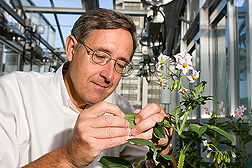This page has been archived and is being provided for reference purposes only. The page is no longer being updated, and therefore, links on the page may be invalid.
Scientists Clarify Origins of Potato Germplasm Neo-Tuberosum
By Stephanie YaoJune 2, 2010
A recent study conducted by scientists with the Agricultural Research Service (ARS) and cooperators shows the potato germplasm Neo-Tuberosum, used by potato breeders to develop new cultivars, has origins that can be traced to Chile, not to the Andes as previously believed.
Native “landrace” potatoes come from two areas: lowland central Chile and the Andes mountains from Venezuela south to northern Argentina. These geographical groups of potato, Solanum tuberosum, differ mainly in day-length adaptation--the amount of daylight needed for them to tuberize or begin to develop. The Andean potato is adapted to short-day conditions widespread in the mountainous, tropical region from which it came. The Chilean potato, on the other hand, evolved under long-day conditions, making it pre-adapted to grow in other long-day- length environments like Europe and North America.
The Andean potato contains many desirable traits, such as virus X and Y resistance, earlier tuberization and greater yield. In the 1960s, an English potato breeder sought to take the Andean potato and adapt it for use in long-day-length regions. This new potato germplasm was named "Neo-Tuberosum" and is widely used by potato breeders to develop new potato varieties.
ARS botanist David Spooner, with the agency’s Vegetable Crop Research Unit in Madison, Wis., and his colleagues at the International Potato Center in Lima, Peru, originally sought to measure how much the genetic base of modern potato varieties and breeders’ lines had broadened with respect to the Andean and Chilean landraces.
Spooner and his collaborators unexpectedly found Neo-Tuberosum is not a product of strict inter-Andean breeding as previously believed. Instead, it’s a descendant of the Chilean potato.
According to Spooner, the study, which was published in Theoretical and Applied Genetics, will change the way this potato species is viewed by scientists—particularly phylogeneticists, who study the evolutionary history of an organism. The discovery will also help researchers gain knowledge of potato classification and identification and will encourage breeders to reexamine the value of the material from the Andean potato.
Read more about this research in the May/June 2010 issue of Agricultural Research magazine.
ARS is the principal intramural scientific research agency of the U.S. Department of Agriculture (USDA). This research supports the USDA priority of promoting international food security.

